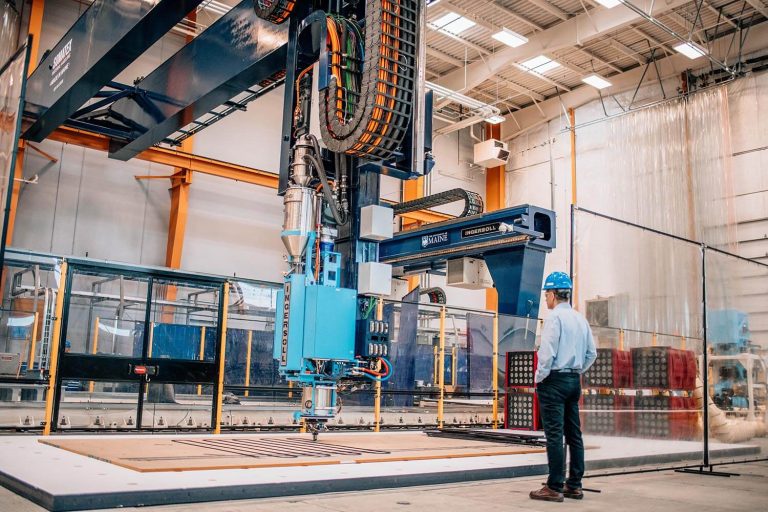At a Strategic Forces Senate hearing, Independent Maine Senator Angus King (I-ME) urged the Department of Defense (DoD) to embrace 3D printing technology for faster, more cost-effective maintenance of military equipment. During the hearing, King expressed his strong support for additive manufacturing (AM), highlighting its potential to revolutionize how the DoD keeps its forces operational.
King’s advocacy stems from the success stories of the University of Maine’s Advanced Structures and Composite Center, which boasts the world’s largest 3D printer. The Center has already delivered results for the DoD, having 3D printed two large-scale vessels in 2022. Outside of that, the machine can be used for 3D printed housing and tooling for wind turbine blades, among other applications.

UMaine’s new polymer 3D printer, the FoF 1.0, the largest polymer 3D printer the world. Image courtesy of UMaine.
“Well, I’m glad to hear about the additive manufacturing. My belief is that there should be a 3D printer on every ship and in every hanger, and that we should be buying the intellectual property when we buy a platform. So, that we can maintain and build parts in a much, much more efficient way,” said King.
King is the Chairman of the Senate Armed Services Committee Subcommittee on Strategic Forces, which oversees the United States’ strategic forces and missile defenses. Incidentally, it is this specific area where AM has proven itself significantly to the DoD. As discussed in depth by 3DPrint.com Macro Analyst Matt Kremenetsky, Ursa Major relies on Velo3D (NYSE: VLD) machines to 3D print solid rocket motors for missile defense. As a small defense supplier, Ursa Major represents a new generation of businesses supporting the DoD with more nimble manufacturing operations. In this regard, companies like Velo3D and its laser supplier, nLight, are poised to be crucial to the development of the Defense Industrial Base due to their role as U.S. suppliers of advanced technology that would otherwise come from what the federal government has labeled as adversaries, i.e. China and Russia.
Admiral William Houston, Deputy Administrator for the Office of Naval Nuclear Reactors, echoed King’s enthusiasm:
“I absolutely agree. The carriers do have printers on them. Some of our submarines have actually deployed with printers, and they’ve actually additively manufactured some components already for that. We need to expand that,” said Admiral Houston. “And it’s more about speed now than it is so much about the process you use. And we find with additive manufacturing that it takes — it’s faster than some of the just pure casting, pouring molten metal into sand and then removing all that excess metal — is all that work that you have to do is taking away from actual production time that you could be using for other things. And, so, I absolutely see it the same way as you do and we just have to keep on leading the way.”
Worth noting here is the significant role that the Navy and its nuclear submarine program have had in AM. As Kremenetsky explains in AM Research’s “Additive Manufacturing for Military and Defense” report, the Navy is essentially setting the standard for 3D printing in such a way that the rest of the armed forces, and then other government bodies, are able to follow suit.
Similarly, at an Appropriations hearing to review the Fiscal Year 2025 budget request for the U.S. Army, U.S. Senator Susan Collins highlighted how UMaine’s capabilities supporting America’s armed services. Senator Collins is the Vice Chair of the Appropriations Committee and Ranking Member of the Subcommittee on Defense.
While advocating for AM adoption in this individual meeting may not in itself increase said adoption, it is indicative of the state of the 3D printing sector. National governments, with the U.S. and China being the biggest players, are essentially carrying AM while the economic markets recover. In the case of the U.S., it is the DoD, with the Navy in the driver’s seat, that this is largely being performed. Next year or the year after that, however, we may see similar conversations in other divisions of the federal government. And, as detailed in “The State of Chinese Additive Manufacturing: Market Opportunity Brief” from AM Research, the same discourse is surely cropping up in China, as well.
Subscribe to Our Email Newsletter
Stay up-to-date on all the latest news from the 3D printing industry and receive information and offers from third party vendors.
Print Services
Upload your 3D Models and get them printed quickly and efficiently.
You May Also Like
Sintokogio Buys Bosch’s Ceramics Unit, Plans Global AM Expansion
Japan’s Sintokogio Group is buying Bosch Advanced Ceramics to expand its work in 3D printed technical ceramics. The agreement was signed on November 18 and formally announced at the Formnext...
7 Ways ASTM is Making AM More Ready for the Real World
Known for setting industry standards, ASTM used this year’s Formnext to launch a global, seven-part initiative to help 3D printing move faster from research to the factory floor. ASTM focused...
Smiles, Selfies, and Super-Sized Prints: Formnext on Social Media
After a week of big announcements and impressive launches, social media posts captured another side of Formnext 2025. Alongside all the technical highlights and product news, people online were sharing...
3D Printing News Briefs, November 22, 2025: Rebranding, Integration, Electronic Eyes, & More
We’ll start with a new software tool from AON3D in today’s 3D Printing News Briefs, and then we’ve got a lot of business, from Conflux Technology and Prima Additive to...

































